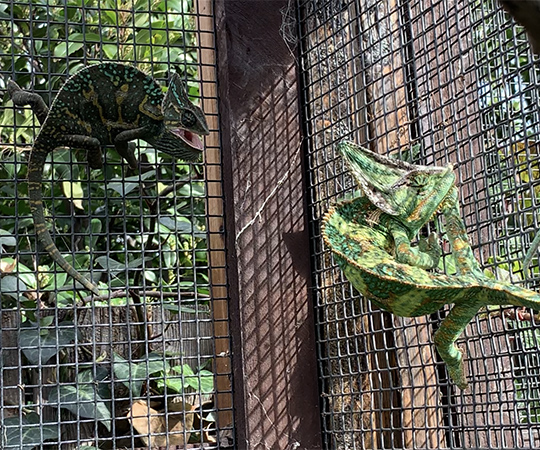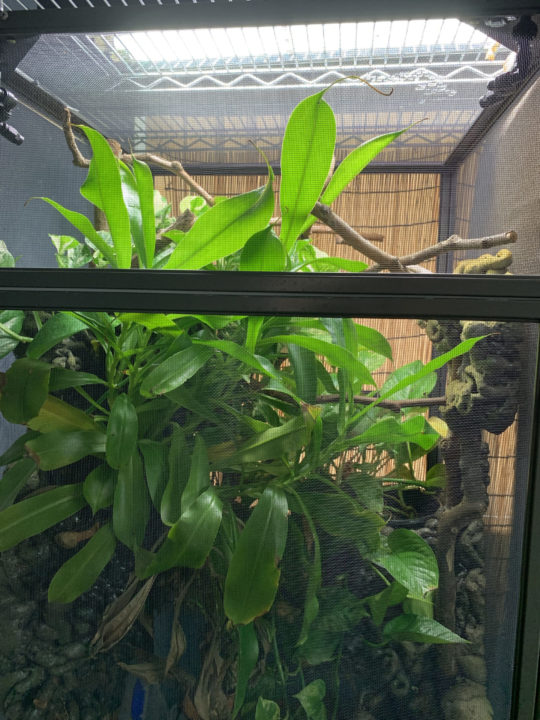Summary: The Chameleon Cage
- Chameleons need an open area for heating up and getting UVB
- Chameleons need a hidden area for feeling secure
- Chameleons prefer horizontal branch perching
- You need a basking branch, a drinking branch, and a hiding branch
- Solid side (PVC or Glass) cages must be used if you need more control over temperature and/or humidity
- Live plants are best
- When starting out, keep the cage floor bare – no substrate necessary
What the Chameleon Cage Should Look Like
The first thing you need to know about chameleons is what their home should look like. The cage shown here is what a chameleon cage should look like. Here is what is important with the cage that you need to replicate
- There is an open area that has light, a basking area, and UVB
- There is a dense planted area where the chameleon can hide and feel secure
- There is a network of branches that allows the chameleon to access all the needed areas including heat, UVB, food, water, and cover
- The network of branches is horizontally orientated. Vertical is fine for getting around, but chameleons generally like to rest horizontally.
The key to creating an effective cage is understanding how to create gradients and microclimates so your chameleon and regulate temperature on its own.
The most common mistake keepers make is not having enough foliage and coverage. The first thing you do when looking at a chameleon cage is ask yourself – Can the chameleon hide from view? Is there a leafy area where they can feel safe? If the answer is “no” then the cage is not adequate for a chameleon. You will find this problem with most of the chameleon set-ups you see.
A gradient is a progression from a high value to a low value with every step in between. For example, the heat gradient starts at the basking branch under the heat lamp and extends to the farthest corner away from the heat lamp that the chameleon can access with a branch. With this set-up the chameleon can effectively regulate its own temperature. It can take care of itself! So, without pulling out a thermometer and just looking at the cage to the right, can you see how this cage would give a chameleon an effective heat gradient? The heat bulb is in the back left side of the cage and branches allow access there and through the foliage and under the foliage. So just by looking at the cage you can tell a heat gradient has been set up. The other gradients are UVB, humidity, and exposure (can the chameleon choose from being in the open or hidden). We will study deeply on each one of these concepts. But for now, simply look at the cage here and consider how each one of these gradients is fulfilled.
Cage Size

For the most common species of chameleons, including the Veiled, Panther, and Jackson’s Chameleons, you should have a minimum of a 2’ x 2’ x 4’ high cage. Wider format cages are better. The 30” and 36” high cages that are commonly sold at pet stores and reptile shows are sufficient starter cages for juveniles, but chameleons grow up quickly. Make plans for the adult size cage and there is no need to wait. If a juvenile chameleon is old enough to be sold, it is old enough to go into a properly filled adult size cage. There is no problem if you choose to start them in a smaller cage, but if the chameleon is so young that it “needs” a smaller cage then reconsider buying this chameleon. Unfortunately, there are places that will sell a chameleon too young to go to a new home. There are so many reasons why it is worth paying the money to get your chameleon from a reputable breeder. This is just one!
The simple answer is the bigger the better.
The practical answer is that 2′ x 2′ x 4′ is an adequate cage size for most commonly kept chameleons.
The accurate answer, that will have a module all its own, is that the cage needs to be big enough that the chameleon can comfortably fit its entire body length in the areas of the gradients you set up. It does little good having a heat gradient that goes from the high value to the low value in the distance equal to the length of your chameleon’s body. So the cage needs to be big enough that you can create a gradient that allows your chameleon to comfortably choose between temperatures, humidities, UVB levels, and security.
Chameleons usually don’t need a lot of space themselves. If they have a safe place to sleep, a place to bask, and a place to hang out to eat and drink they are happy. This can be done in a surprisingly small space. But for you to create areas along the gradients that a chameleon can place their body requires a cage size whose dimensions are larger as the chameleon’s body gets larger.
Ventilation: Screen vs. Glass

If you have spent time browsing chameleon care sheets you will probably have run across the statement that chameleons need screen cages or they will get sick and die. This is simply not true. There are times when screen cages are appropriate and times when glass cages are appropriate and times when a hybrid between screen and solid sides is exactly what is needed. It is all about how much ventilation you need considering your environment. If you live in an environment that is close to what the chameleon needs then a screen cage is appropriate. If you need more control over the internal environment for greater heat and humidity then a glass cage is what you need. Most people in the US and Europe can benefit from a hybrid cage which often has three solid sides and a front and top screen. Part of the training we will do here at the Academy is to teach you how to determine which cage material is right for you.
Screen cages, hybrid cages, and glass cages are tools that have their place. The more screen the more ventilation and the dispersion of heat and humidity. The more solid sides the more control you have over the environment. The proper cage, therefore, a judgement based on your environment.
Most advice is based on screen cage experience. So screen cages are the type that have the most community experience and support. You cannot directly transfer advice for heat lamps and misting schedules from screen cage strategies to solid side cages.
Plants

Plant cover is critical for the security of your chameleon. Plants will be able to provide the cover and leaf drinking that chameleons need. Plants also add to the humidity and overall “life” of the environment.
In our educational program we will be focusing on integrating live plants into the chameleon home. Plastic plants has been used without issue by many breeders for decades. They are easy to use and easy to disinfect. They can also add greenery and cover in cage areas that will not fit a pot of dirt. They have their uses. But having them in with Veiled Chameleons can get troublesome if the chameleon takes a bite and swallows the plastic. And any chameleon could decide to take a bite. I will not spend much time on plastic plants. We will go deeply into the plant kingdom to understand how to keep a living environment for our chameleons.
The three of the most used plants are Pothos (Epipremnum aureum), Umbrella Plant (Schefflera arboricola) and the Ficus tree (Ficus benjamina). Both the Umbrella Plant and Ficus tree may be placed on the bottom of the cage floor. Pothos is best as a trailing plant and can be mounted to the sides of the cage with equipment such as the Dragon Strand Dragon Ledges.
No matter what plants you use, their functions are 1) to provide a hiding space so your chameleon can feel safe. That means enough leaves that you can’t see them when they want to hide. 2) surfaces to drink. This means that there is a drip or mist systems that produces water on leaves that are within easy reach of a perching branch. And 3) To provide a humidity pocket. Live plants produce humidity which is beneficial for chameleons.
The ideal set-up will have a leafy place where the chameleon can disappear and be surrounded by plants.
Branches

Chameleons need perching space and they like to perch horizontally. This requires that branches be placed horizontally in the cage. There are a number of ways to accomplish this in a screen cage. The highest quality solution is to install Dragon Strand Dragon Ledges as they will allow you to mount both branches and plants. Cheap solutions include thumb tacks through the screen or hanging from fishing line from the cage frame. Some people create wood lattices across the side of the cage. Whatever the strategy used, the branches should be horizontally orientated and connected by vertical and diagonal branch pathways. Give access to as much of the cage as is possible! Branches should be in various diameters with the maximum being just large enough that they can only wrap their feet half way around it. They can use thicker branches for climbing, of course, but the thinner ones are preferred.
There are four most important branch functions.
- The basking branch. This is the branch that is where the chameleon gets its heat and UVB. This branch is usually six inches from the top under the UVB lamp appropriate for the species. The basking bulb shines on the spot of highest UVB exposure
- The drinking spot. This is the branch that is close enough to the leaves that have water dripping down on them for drinking. Now, this doesn’t have to be a separate branch, but there must be branch space that performs this function!
- The eating spot: There needs to be a branch within tongue range of whatever feeding method you choose to use.
- The hiding branch. This is a horizontal branch that allows your chameleon to hide behind leaves. Shy chameleons will go there to hide, sleep, and retreat when they just don’t feel like dealing with your nonsense, or a stranger comes in the room.
Some people use branches they pick up in safe natural areas and some like to be extra carful and get branches that have been disinfected and baked. Either way has worked very well.
The Cage Floor

Most cages come with a plastic floor. This is sufficient for keeping your chameleon. Especially when starting out there is no reason to work with a substrate (meaning dirt or wood chips or anything else).
The one thing you will have to plan for is where excess water will go. There needs to be a drainage solution. The most effective method to solve this problem is a drainage tray that collects the water under the cage with the cage on risers so it is not in the water. If you have a drainage tray then a network of drilled holes will encourage drainage. Some keepers that do not have a drainage tray will line the bottom of the cage floor with paper towels, puppy pee pads, or carpet. These are not ideal as they soak up water and keep it in contact with the cage interior. This allows the unhygienic combination of moisture, poop, and escaped feeder insects. So you have a breeding ground for bacteria and a delivery mechanism to your chameleon. A drainage tray removes as much of this risk as is possible.
Bio-active set-ups, where the soil contains cleaning organisms, are a project in themselves. It will be one we look into more in the future here, but a soil floor has limited direct value to the commonly kept chameleons. It does, however create a valuable mindset in the keeper and so has great value in our future. But, when you are starting out, it is a good idea to keep things simple and a bare floor with drainage underneath is the ideal starting point.
Substrate

A substrate refers to including a soil floor in your husbandry. Including a substrate for a chameleon cage is not necessary for the chameleon and, for the standard chameleons, offers little direct benefit. But, at the same time, it can be incredibly rewarding for you to grow live pants or even explore a bioactive substrate. As a beginner it is best to keep a plain floor. Substrates are a complication that is best to tackle once you can confidently care for your chameleon. But as a chameleon keeper grows in their skill they will more and more embrace the naturalistic approach and a soil substrate will be just one component in the keeping of an environment rather than just the keeping of a chameleon.
Outdoor Caging

With indoor husbandry we send so much time an effort figuring out how to get the correct UVB, heat spot, natural hydration cycle, and air flow. Outdoors keeping, during the months where your environmental conditions are within the chameleon’s desired ranges, gives your chameleon these things in a natural way. In fact, just providing unfiltered sunlight can do wonders for a chameleon’s health.
But for all the benefits of outdoor keeping, there come many dangers if it is not done correctly. It is not as simple as just bringing your inside cage outside. This could easily kill your chameleon due to overheating.
Most of the time you can get some indirect sunlight – which still has UVB in it – by placing your screen cage out on a covered patio so it gets direct sunlight during the morning, but is shaded once the day temperature starts to rise. Direct sunlight hitting a cage set up for our weak indoor lights will result in dead chameleons from overheating. But outdoor keeping has so many benefits that it is worth making it happen! This is a huge topic. If this is of interest to you, you can get a jump on your studies by listening to this podcast episode below.
Multiple Chameleons and Co-Habitation

Chameleons should be kept individually. They can survive for a time together, but this is a low grade stress situation for them. This is one of the community’s biggest, yet most avoidable problem due to human beings insisting they need to be together or just not understanding chameleon body language. It does not help that pet store owners and reptile show vendors continue to sell pairs of chameleons with the instruction that they can be kept together. Incredulously, some insist that the pair loves each other and can’t be separated! This is a misinterpretation of the dominance play and their perching close together is anything but “love”. The bottom line is simple – do not keep chameleons together. This includes Jackson’s Chameleons. In fact, I will say especially Jackson’s Chameleons to try and reverse so much misinformation still being pushed in the community. So many Jackson’s Chameleon have suffered for this. Please do not perpetuate this habit. Stick with the rule of one chameleon per cage and you will have a much more enjoyable chameleon keeping experience.
Navigation
This seminar is part of the introductory course Chameleon Basics which, in turn, is a module within the even larger Term 1: Getting Started With Chameleons.




